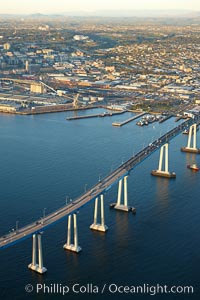
San Diego Coronado Bridge, known locally as the Coronado Bridge, links San Diego with Coronado, California. The bridge was completed in 1969 and was a toll bridge until 2002. It is 2.1 miles long and reaches a height of 200 feet above San Diego Bay. Coronado Island is to the left, and downtown San Diego is to the right in this view looking north.
Location: San Diego, California
Image ID: 22467
Location: San Diego, California
Image ID: 22467
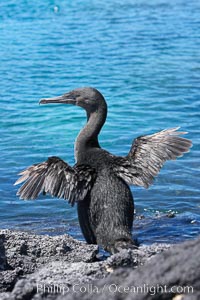
Flightless cormorant dries its stubby wings after emerging from the ocean. In the absence of predators and thus not needing to fly, the flightless cormorants wings have degenerated to the point that it has lost the ability to fly, however it can swim superbly and is a capable underwater hunter. Punta Albemarle.
Species: Flightless cormorant, Nannopterum harrisi, Phalacrocorax harrisi
Location: Isabella Island, Galapagos Islands, Ecuador
Image ID: 16546
Species: Flightless cormorant, Nannopterum harrisi, Phalacrocorax harrisi
Location: Isabella Island, Galapagos Islands, Ecuador
Image ID: 16546
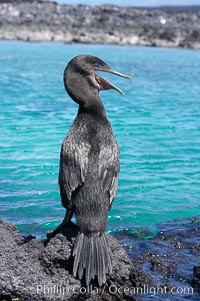
Flightless cormorant perched on volcanic coastline. In the absence of predators and thus not needing to fly, the flightless cormorants wings have degenerated to the point that it has lost the ability to fly, however it can swim superbly and is a capable underwater hunter. Punta Albemarle.
Species: Flightless cormorant, Nannopterum harrisi, Phalacrocorax harrisi
Location: Isabella Island, Galapagos Islands, Ecuador
Image ID: 16547
Species: Flightless cormorant, Nannopterum harrisi, Phalacrocorax harrisi
Location: Isabella Island, Galapagos Islands, Ecuador
Image ID: 16547
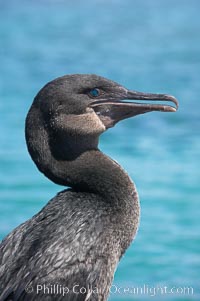
Flightless cormorant. In the absence of predators and thus not needing to fly, the flightless cormorants wings have degenerated to the point that it has lost the ability to fly, however it can swim superbly and is a capable underwater hunter. Punta Albemarle.
Species: Flightless cormorant, Nannopterum harrisi, Phalacrocorax harrisi
Location: Isabella Island, Galapagos Islands, Ecuador
Image ID: 16552
Species: Flightless cormorant, Nannopterum harrisi, Phalacrocorax harrisi
Location: Isabella Island, Galapagos Islands, Ecuador
Image ID: 16552
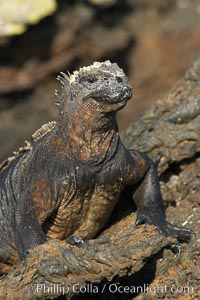
Marine iguana on volcanic rocks at the oceans edge, Punta Albemarle.
Species: Marine iguana, Amblyrhynchus cristatus
Location: Isabella Island, Galapagos Islands, Ecuador
Image ID: 16576
Species: Marine iguana, Amblyrhynchus cristatus
Location: Isabella Island, Galapagos Islands, Ecuador
Image ID: 16576
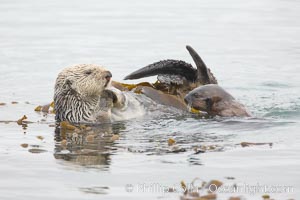
A female sea otter floats on its back on the ocean surface while her pup pops its head above the water for a look around. Both otters will wrap itself in kelp (seaweed) to keep from drifting as it rests and floats.
Species: Sea otter, Enhydra lutris
Location: Morro Bay, California
Image ID: 20434
Species: Sea otter, Enhydra lutris
Location: Morro Bay, California
Image ID: 20434
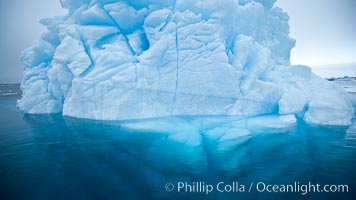
Iceberg above water and some of the underwater portion seen as well.
Location: Brown Bluff, Antarctic Peninsula, Antarctica
Image ID: 24802
Location: Brown Bluff, Antarctic Peninsula, Antarctica
Image ID: 24802
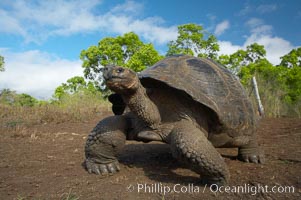
Galapagos tortoise, Santa Cruz Island species, highlands of Santa Cruz island.
Species: Galapagos tortoise, Geochelone nigra
Location: Santa Cruz Island, Galapagos Islands, Ecuador
Image ID: 16490
Species: Galapagos tortoise, Geochelone nigra
Location: Santa Cruz Island, Galapagos Islands, Ecuador
Image ID: 16490
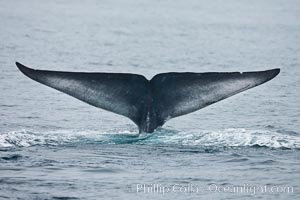
Blue whale fluke (tail) lifted high above the water as the whale dives in the Santa Barbara Channel.
Species: Blue whale, Balaenoptera musculus
Location: Santa Rosa Island, California
Image ID: 27042
Species: Blue whale, Balaenoptera musculus
Location: Santa Rosa Island, California
Image ID: 27042
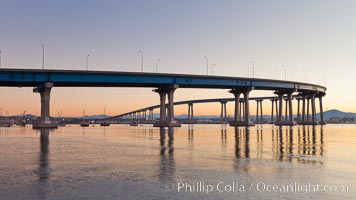
Coronado Bridge, linking San Diego to Coronado, sunrise, viewed from Coronado Island. San Diego Coronado Bridge, known locally as the Coronado Bridge, links San Diego with Coronado, California. The bridge was completed in 1969 and was a toll bridge until 2002. It is 2.1 miles long and reaches a height of 200 feet above San Diego Bay.
Location: San Diego, California
Image ID: 27094
Location: San Diego, California
Image ID: 27094
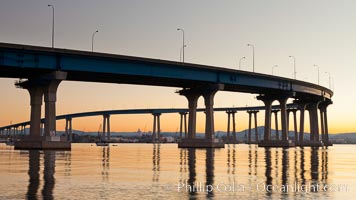
Coronado Bridge, linking San Diego to Coronado, sunrise, viewed from Coronado Island. San Diego Coronado Bridge, known locally as the Coronado Bridge, links San Diego with Coronado, California. The bridge was completed in 1969 and was a toll bridge until 2002. It is 2.1 miles long and reaches a height of 200 feet above San Diego Bay.
Location: San Diego, California
Image ID: 27095
Location: San Diego, California
Image ID: 27095
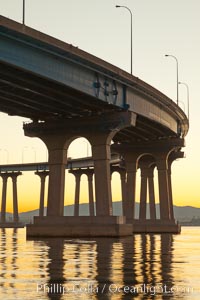
Coronado Bridge, linking San Diego to Coronado, sunrise, viewed from Coronado Island. San Diego Coronado Bridge, known locally as the Coronado Bridge, links San Diego with Coronado, California. The bridge was completed in 1969 and was a toll bridge until 2002. It is 2.1 miles long and reaches a height of 200 feet above San Diego Bay.
Location: San Diego, California
Image ID: 27096
Location: San Diego, California
Image ID: 27096
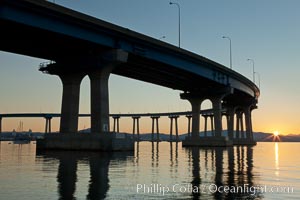
Coronado Bridge, linking San Diego to Coronado, sunrise, viewed from Coronado Island. San Diego Coronado Bridge, known locally as the Coronado Bridge, links San Diego with Coronado, California. The bridge was completed in 1969 and was a toll bridge until 2002. It is 2.1 miles long and reaches a height of 200 feet above San Diego Bay.
Location: San Diego, California
Image ID: 27097
Location: San Diego, California
Image ID: 27097
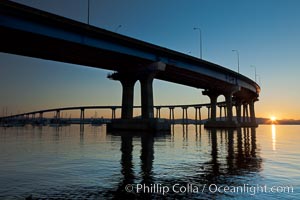
Coronado Bridge, linking San Diego to Coronado, sunrise, viewed from Coronado Island. San Diego Coronado Bridge, known locally as the Coronado Bridge, links San Diego with Coronado, California. The bridge was completed in 1969 and was a toll bridge until 2002. It is 2.1 miles long and reaches a height of 200 feet above San Diego Bay.
Location: San Diego, California
Image ID: 27098
Location: San Diego, California
Image ID: 27098
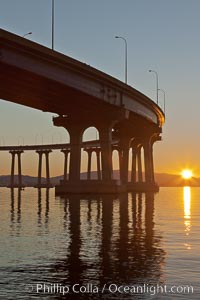
Coronado Bridge, linking San Diego to Coronado, sunrise, viewed from Coronado Island. San Diego Coronado Bridge, known locally as the Coronado Bridge, links San Diego with Coronado, California. The bridge was completed in 1969 and was a toll bridge until 2002. It is 2.1 miles long and reaches a height of 200 feet above San Diego Bay.
Location: San Diego, California
Image ID: 27099
Location: San Diego, California
Image ID: 27099
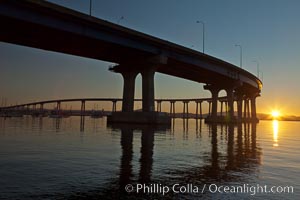
Coronado Bridge, linking San Diego to Coronado, sunrise, viewed from Coronado Island. San Diego Coronado Bridge, known locally as the Coronado Bridge, links San Diego with Coronado, California. The bridge was completed in 1969 and was a toll bridge until 2002. It is 2.1 miles long and reaches a height of 200 feet above San Diego Bay.
Location: San Diego, California
Image ID: 27100
Location: San Diego, California
Image ID: 27100
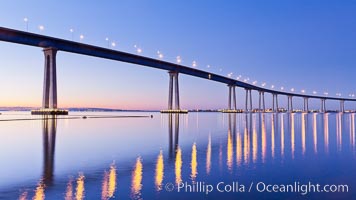
San Diego Coronado Bridge, linking San Diego to the island community of Coronado, spans San Diego Bay. Dawn, lavender sky.
Location: San Diego, California
Image ID: 27703
Location: San Diego, California
Image ID: 27703
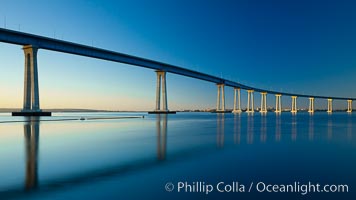
San Diego Coronado Bridge, linking San Diego to the island community of Coronado, spans San Diego Bay. Dawn.
Location: San Diego, California
Image ID: 27704
Location: San Diego, California
Image ID: 27704
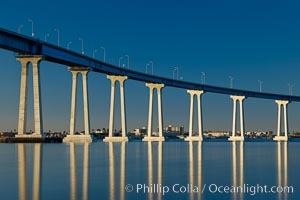
San Diego Coronado Bridge, linking San Diego to the island community of Coronado, spans San Diego Bay. Dawn.
Location: San Diego, California
Image ID: 27705
Location: San Diego, California
Image ID: 27705
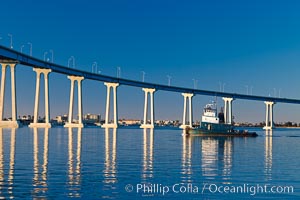
San Diego Coronado Bridge, linking San Diego to the island community of Coronado, spans San Diego Bay. Dawn.
Location: San Diego, California
Image ID: 27706
Location: San Diego, California
Image ID: 27706
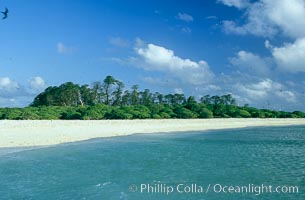
Rose islet and Pisonia trees.
Location: Rose Atoll National Wildlife Sanctuary, American Samoa
Image ID: 00830
Location: Rose Atoll National Wildlife Sanctuary, American Samoa
Image ID: 00830
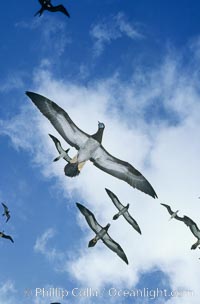
Brown boobies.
Species: Brown booby, Sula leucogaster
Location: Rose Atoll National Wildlife Sanctuary, American Samoa
Image ID: 00908
Species: Brown booby, Sula leucogaster
Location: Rose Atoll National Wildlife Sanctuary, American Samoa
Image ID: 00908
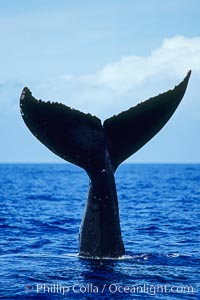
North Pacific humpback whale, fluke held above water.
Species: Humpback whale, Megaptera novaeangliae
Location: Maui, Hawaii
Image ID: 05872
Species: Humpback whale, Megaptera novaeangliae
Location: Maui, Hawaii
Image ID: 05872
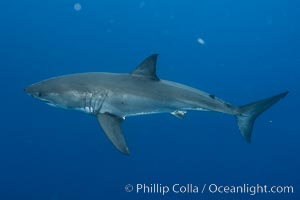
Great white shark, research identification photograph. A great white shark is countershaded, with a dark gray dorsal color and light gray to white underside, making it more difficult for the shark's prey to see it as approaches from above or below in the water column. The particular undulations of the countershading line along its side, where gray meets white, is unique to each shark and helps researchers to identify individual sharks in capture-recapture studies. Guadalupe Island is host to a relatively large population of great white sharks who, through a history of video and photographs showing their countershading lines, are the subject of an ongoing study of shark behaviour, migration and population size.
Species: Great white shark, Carcharodon carcharias
Location: Guadalupe Island (Isla Guadalupe), Baja California, Mexico
Image ID: 28761
Species: Great white shark, Carcharodon carcharias
Location: Guadalupe Island (Isla Guadalupe), Baja California, Mexico
Image ID: 28761
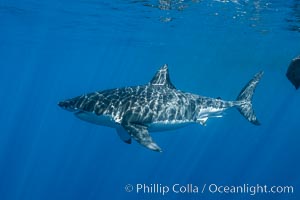
Great white shark, research identification photograph. A great white shark is countershaded, with a dark gray dorsal color and light gray to white underside, making it more difficult for the shark's prey to see it as approaches from above or below in the water column. The particular undulations of the countershading line along its side, where gray meets white, is unique to each shark and helps researchers to identify individual sharks in capture-recapture studies. Guadalupe Island is host to a relatively large population of great white sharks who, through a history of video and photographs showing their countershading lines, are the subject of an ongoing study of shark behaviour, migration and population size.
Species: Great white shark, Carcharodon carcharias
Location: Guadalupe Island (Isla Guadalupe), Baja California, Mexico
Image ID: 28762
Species: Great white shark, Carcharodon carcharias
Location: Guadalupe Island (Isla Guadalupe), Baja California, Mexico
Image ID: 28762
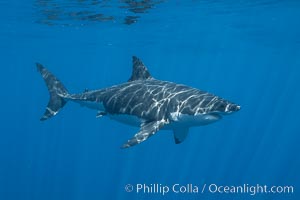
Great white shark, research identification photograph. A great white shark is countershaded, with a dark gray dorsal color and light gray to white underside, making it more difficult for the shark's prey to see it as approaches from above or below in the water column. The particular undulations of the countershading line along its side, where gray meets white, is unique to each shark and helps researchers to identify individual sharks in capture-recapture studies. Guadalupe Island is host to a relatively large population of great white sharks who, through a history of video and photographs showing their countershading lines, are the subject of an ongoing study of shark behaviour, migration and population size.
Species: Great white shark, Carcharodon carcharias
Location: Guadalupe Island (Isla Guadalupe), Baja California, Mexico
Image ID: 28763
Species: Great white shark, Carcharodon carcharias
Location: Guadalupe Island (Isla Guadalupe), Baja California, Mexico
Image ID: 28763
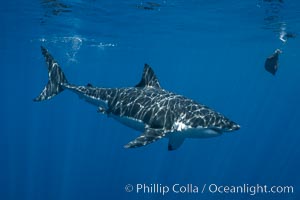
Great white shark, research identification photograph. A great white shark is countershaded, with a dark gray dorsal color and light gray to white underside, making it more difficult for the shark's prey to see it as approaches from above or below in the water column. The particular undulations of the countershading line along its side, where gray meets white, is unique to each shark and helps researchers to identify individual sharks in capture-recapture studies. Guadalupe Island is host to a relatively large population of great white sharks who, through a history of video and photographs showing their countershading lines, are the subject of an ongoing study of shark behaviour, migration and population size.
Species: Great white shark, Carcharodon carcharias
Location: Guadalupe Island (Isla Guadalupe), Baja California, Mexico
Image ID: 28764
Species: Great white shark, Carcharodon carcharias
Location: Guadalupe Island (Isla Guadalupe), Baja California, Mexico
Image ID: 28764
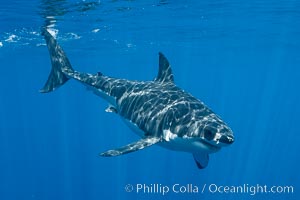
Great white shark, research identification photograph. A great white shark is countershaded, with a dark gray dorsal color and light gray to white underside, making it more difficult for the shark's prey to see it as approaches from above or below in the water column. The particular undulations of the countershading line along its side, where gray meets white, is unique to each shark and helps researchers to identify individual sharks in capture-recapture studies. Guadalupe Island is host to a relatively large population of great white sharks who, through a history of video and photographs showing their countershading lines, are the subject of an ongoing study of shark behaviour, migration and population size.
Species: Great white shark, Carcharodon carcharias
Location: Guadalupe Island (Isla Guadalupe), Baja California, Mexico
Image ID: 28765
Species: Great white shark, Carcharodon carcharias
Location: Guadalupe Island (Isla Guadalupe), Baja California, Mexico
Image ID: 28765
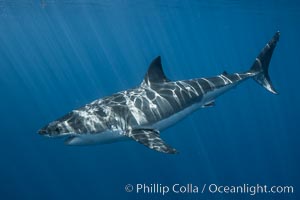
Great white shark, research identification photograph. A great white shark is countershaded, with a dark gray dorsal color and light gray to white underside, making it more difficult for the shark's prey to see it as approaches from above or below in the water column. The particular undulations of the countershading line along its side, where gray meets white, is unique to each shark and helps researchers to identify individual sharks in capture-recapture studies. Guadalupe Island is host to a relatively large population of great white sharks who, through a history of video and photographs showing their countershading lines, are the subject of an ongoing study of shark behaviour, migration and population size.
Species: Great white shark, Carcharodon carcharias
Location: Guadalupe Island (Isla Guadalupe), Baja California, Mexico
Image ID: 28766
Species: Great white shark, Carcharodon carcharias
Location: Guadalupe Island (Isla Guadalupe), Baja California, Mexico
Image ID: 28766
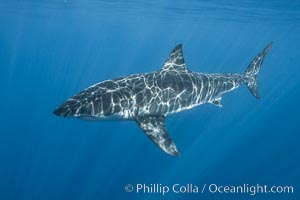
Great white shark, research identification photograph. A great white shark is countershaded, with a dark gray dorsal color and light gray to white underside, making it more difficult for the shark's prey to see it as approaches from above or below in the water column. The particular undulations of the countershading line along its side, where gray meets white, is unique to each shark and helps researchers to identify individual sharks in capture-recapture studies. Guadalupe Island is host to a relatively large population of great white sharks who, through a history of video and photographs showing their countershading lines, are the subject of an ongoing study of shark behaviour, migration and population size.
Species: Great white shark, Carcharodon carcharias
Location: Guadalupe Island (Isla Guadalupe), Baja California, Mexico
Image ID: 28767
Species: Great white shark, Carcharodon carcharias
Location: Guadalupe Island (Isla Guadalupe), Baja California, Mexico
Image ID: 28767